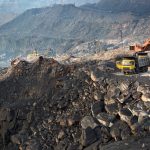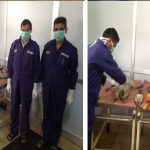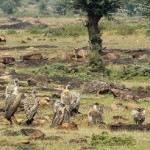IndiaWilds Newsletter Vol 2 Issue VII
It is my pleasure to bring you the IndiaWilds Newsletter Vol.2 Issue VII. This issue examines the impact of various infrastructure projects on environment and a way forward. The newsletter is available online at http://www.indiawilds.com/diary/indiawilds-newsletter-vol-2-issue-vii and you can also post your views directly in the article.
Infrastructure creation and Conservation:
Recently I was talking with a representative of a foreign investor who is concerned about their investments in power projects that has attracted opposition due to environmental issues. As conservationists fighting against such projects coming up in wetlands or other such ecologically fragile areas, at times one can have a modicum of satisfaction of having stopped an ecologically disastrous project. However, when one hears that several state Governments have agreed to create huge petrochemical complexes and to other so called infrastructure creation in some of the ecologically sensitive places, one realises that it is mostly a losing battle because conservation is seen as anti-development.
The infrastructure bug has bitten us, albeit at the wrong places.
The realization has dawned that India’s economy can accelerate its growth if there is enabling infrastructure in terms of road, power etc. So the Government is sprinting ahead in a missionary zeal in setting up mega infrastructure creation; creating roads by cutting across pristine forests instead of finding alternate alignments, setting up polluting thermal power plants in wetlands, hydel power plants in pristine forests etc. We need to realise that “BIG” is not always the better solution. A simple alternate solution could have sufficed for a major part of our problems. However, big is eye catching and hence those big solutions, inspite of their adverse ecological impact are pushed through in the name of development.
Power:
As an emerging economy, we are power hungry and are guzzling energy like a monster. There is an increased demand for energy with each passing day. Obviously, the planners will thing of augmenting the total power generation capacity. You may consider it to be a right decision, unless you notice that this is akin to a leaking ship. The planners obviously are trying to remove water that is entering into the leaking ship without thinking of plugging the ship. For example, the electricity transmission and distribution suffers from 30 percent losses. At an installed base of 180,000 Megawatts power generation capacity, the losses amount to 60,000 MW. This means, 15 Ultra Mega power project of 4000 MW size. When you look at the details of one of those being set up near Telineelapuram at the ecologically fragile Naupada swamps, (for further details you can check here http://www.indiawilds.com/forums/showthread.php?t=249 ) you can realise how many thousands of acres of land and biodiversity we can save. My further thoughts of Energy efficiency and Green Power can be found here: http://www.indiawilds.com/diary/energy-efficiency-green-power
Apart from plugging the leaking ship ie. increasing the efficiencies and reducing power losses, we should actively look at harnessing Solar power. Though I have been talking about this often, I was surprised to see the work being done in Botswana. As readers of this newsletter may recall, I have been studying the conservation best practices in African national parks and countries. In IndiaWilds Newsletter Vol 2 Issue IV ( http://www.indiawilds.com/diary/indiawilds-newsletter-vol-2-issue-iv ) , I had talked about ecotourism best practice in Botswana. Little did I realise, that we can also learn from Botswana regarding deployment of alternative energy.
Solar Power initiative of Botswana Power Corporation:
The Botswana Power Corporation (BPC), which is a national electricity utility, has been providing solar energy services to Botswana’s rural citizens. Solar lanterns, wood-saving stoves, hot bags that keep the food warm etc are some notable efforts that are being undertaken. I have often been saying that wiring up remote villages leads to huge transmission losses and is costly. This cost of wheeling power over long distances is not reflected in the cost of the power. When one considers this, solar energy becomes competitive in terms of cost. It would be good if the Government through suitable legislation helps in adoption of solar power and other renewable energy sources so that the dependence on the inefficient thermal power as well as huge hydroelectricity projects is reduced.
Green SEZs:
In a small effort towards green power, the Ministry of Commerce in its Draft Guidelines for Green SEZs (Special Economic Zones) issued in July 2009, has mentioned that 2% of total estimated energy consumption for each zone or 5KW/hectare, whichever is lower, must be generated through solar or other renewable energy. Over a period of 10 years, the solar/other forms of renewable energy must be extended from 2% to a minimum of 20% of total estimated energy consumption or 50KW/hectare whichever is lower. Though these are still in the draft guidelines stage even after a year, I am hopeful that the usage of Solar and alternate energy can be increased in industries as well as at homes there by reducing the need for huge infrastructure creation with its associated problems both interms of ecological footprint as well as cultural impact.
Continuous Green patch in SEZs and Industrial Areas:
Given that the industrialization is only going to increase in future, a few change in rules can help in creating micro habitats for our wildlife. At the moment, the Special Economic zones need to maintain 25% area as green area. Unfortunately, due to the lack of a suitable definition, playgrounds, pathways, lawns with artificial Korean grass etc are referred to as green areas. Also, the area earmarked as green areas are not contiguous and hence doesn’t help in serving as habitat for wildlife. Ofcourse, I am not visualizing megafauna to reside in these industrial complexes, especially after a venerable institute like the Wildlife Institute of India setting fire on the vegetation to drive away a leopard (for details read here http://www.indiawilds.com/forums/showthread.php?t=4104 ), I am sure that this place can serve as a habitat for avifauna, butterflies and bees as well as a few less glamorous species if there is sufficient space for them. So a regulation to ensure that the 25% of area to be maintained as a continuous patch of green area would serve the purpose. A back of the envelope calculation tells me that the total area of SEZs in this country stands at 43430 hectares and 25% of this amounts to 10857 hectares of green area.
Indigenous Species:
Another issue that is not given due importance is the need to promote native species instead of planting exotic species. During my formative years, when I was too young to understand what an exotic species means, I had read that the noted naturalist Shri M. Krishnan was against Gulmohur trees as it is not an indigenous species. A few years back, I was shocked when one of the large global NGOs working in this country suggested planting of Lantana (Lantana camara) in SEZs to create suitable habitat for birds. I am sure it is time to generate awareness about promoting indigenous species and maintaining a habitat suitable to the geography. I wish some of our knowledgeable researchers and conservationists can come forward in creating a checklist of species native to each State and district. We can then try to sensitise industry as well as the Government in amending the green guidelines.
Together with the rule for creating continuous patch of green area and ensuring no exotic species, we can thus win small battles, though we are losing the greater war. That will continue unless the current economic modeling incorporates green economics.
Damning a River!
The environmental impact of big dams on rivers is well known.
India is blessed with a large number of perennial rivers. So the dams appear as an attractive proposition to solve our power and water needs. However, the environmental impact of big dams is well known. Huge chunks of pristine forests are submerged due to our dams. And after a few years, our dams lose their carrying capacity due to heavy siltation. Naturally, the generation of hydel power reduces. This problem is accentuated, when there is more of destruction of forests in the upstream. Unfortunately, our planners fail to take these into their calculations.
There is ofcourse a compensation amount given to people who are directly impacted. However, due to lack of understanding and studies, we don’t know the impact on others.
When a river is dammed (read damned), in many cases it changes the lives of people irreversibly. Perennial rivers dry up and become seasonal, impacting not only the lives of fishermen but also agriculture as the flood plains are starved of nutrients and the ground water is not recharged. It is also a fact that, the drying up of rivers leads to salt water intrusion and increased salinity. And in a country where the rivers are worshiped as Goddesses, the drying up of a river has a cultural impact on people. The planners fail to notice the impact on the people living downstream.
Similarly, we don’t realise the impact on flora and fauna. Dams come across as a major barrier in stopping migration of aquatic species. Some even move towards extirpation/extinction. However, there are no champions for them. And the salinity level increases near the delta region, has its impact on the wildlife too. There have been recent reports of the tigers in Sunderbans moving north due to the increase in salinity. You can now realise, it is not just an issue of getting several megawatts of power or irrigating several hundred acres of land near a dam. The impact is much more profound.
Please check here for a detailed impact assessment of one of the projects (Pancheswar Dam http://www.indiawilds.com/forums/showthread.php?t=4334 ) and also to raise your voice against it. The document prepared by Dr. Mark Everard a leading expert in wetlands is certainly going to help in increasing knowledge.
In another case, the committee of ministers headed by Shri Pranab Mukherjee has given a go ahead to the Loharinag Pala hydroelectric project, on the specious reason that money has already been sunk in the project and contracts awarded. For further details please check here ( http://www.indiawilds.com/forums/showthread.php?t=4360 )
Unless, we quickly move in to tap alternate energy resources, we will continue to build such huge hydel power projects, thermal power projects etc with their associated ill effects on the environment. The relentless march of so called development or infrastructure creation will continue, unless we push for a better, simpler and non polluting solution.
Golden Dream:
In response to my previous newsletter, (http://www.indiawilds.com/diary/indiawilds-newsletter-vol-2-issue-vi ) several conservationists had urged me not to lose hope and I had promised to try to glean learnings from our failures. So the question arises, what do we do now?
The answer in short is, Dream Big.
When our former Prime Minister Shri Atal Bihari Vajpayee had announced the Golden Quadrilateral – the four-laning of roads connecting the four metro cities – and the East-West and North-South corridors, it was branded as too grandiose a dream by his friends and foes alike. Today, everyone realises the power of that dream. In that backdrop, what stops us from dreaming big?
The way Shri Vajpayeeji had dreamt of creating roads for the human species, why can’t we dream of creating roads (read corridors) for the animal species? Why can’t we dream of creating corridors to establish linkages between all our National Parks and wilderness areas. Today, our tiger reserves and national parks are like jewels. Any lay man can vouch for the fact that the value of those jewels are enhanced when the jewels are strung together to create a necklace.
Can we dream of creating such a beautiful necklace with our tiger reserves and national parks connected by corridors? The costs may be to the order of a couple of hundred thousand crores, and there would be sceptics. Remember, when the road building activity started, nobody realised the impact. Only later, the positive impact on the industries like cement, steel etc was realised, and the impact on job creation, lowering transportation costs, linking village economies with the urban economies etc were realised. Similarly, linking our tiger reserves and national parks, will help in securing first and foremost our fresh water resources, help in carbon sequestration, enhancing genetic diversity of our wildlife etc. It will also help us in reining in the climate change, which is going to hit us hard if adequate measures are not taken. The farmers and the poor are the most vulnerable, and if we as a nation are concerned about our farmers and the poor, then we should take such steps.
Now we have to find out who is going to be the so called Mungeri Lal to dream such haseen sapne (golden dreams). I hope we can find a way to sell this dream to a person who wields considerable influence like Mrs. Sonia Gandhi. The tiger earlier had a strong champion in Mrs. Indira Gandhi, our former Prime Minister. Will her daughter-in-law who has proved herself as a successful leader, can lead us towards such a golden dream?
I have a prayer in my lips hoping this linking of the wilderness areas – the true India – comes to fruition in my lifetime.
Conservation:
You may check the following discussions in the conservation section of IndiaWilds forums:
Critically endangered Fish:
http://www.indiawilds.com/forums/showthread.php?t=4336
Man in the Life of a Snake:
http://www.indiawilds.com/forums/showthread.php?t=4328
Leopard illegally caged in Aravalis:
http://www.indiawilds.com/forums/showthread.php?t=4380
Rally in wildlife sanctuary kills deer:
http://www.indiawilds.com/forums/showthread.php?t=4322
Wildlife Photography:
Every month we highlight a few images for their aesthetic abilities, natural history importance or for increasing our knowledge of a little known species from a particular habitat. Please check the following links to access the images.
The green predator by Dr Hari Venkatesh K R
http://www.indiawilds.com/forums/showthread.php?t=4206
Gir Lion by Atul Dhamankar
http://www.indiawilds.com/forums/showthread.php?t=4284
Tusker from Kabini by Vishwanath M K
http://www.indiawilds.com/forums/showthread.php?t=4267
Slender Loris rescued by Akshay Kumar Manjunath
http://www.indiawilds.com/forums/showthread.php?t=4313
Black buck from Maidenahalli by Subramanya CK
http://www.indiawilds.com/forums/showthread.php?t=4309
Blackbuck from Betanai, Orissa by Satyabrata Mishra
http://www.indiawilds.com/forums/showthread.php?t=4310
Tiger Cub, Siddhababa, Bandhavgarh by Anup Ranadive
http://www.indiawilds.com/forums/showthread.php?t=4225
Pied Kingfisher from Ranganathittu by Mrudul
http://www.indiawilds.com/forums/showthread.php?t=4329
Grey Heron from Mangalajodi, Orissa by Satyabrata Mishra
http://www.indiawilds.com/forums/showthread.php?t=4307
Indian Courser by Jitendra Katre
http://www.indiawilds.com/forums/showthread.php?t=4218
Seashore in Ratnagiri in November by Vishal Bhave
http://www.indiawilds.com/forums/showthread.php?t=4193
Sunset at Redi, Konkan by Amit Paralikar
http://www.indiawilds.com/forums/showthread.php?t=4140
Look forward to your inputs and your support in preserving the last tracts of wilderness and wildlife left in this beautiful country. For other interesting articles and photographs please check:
http://www.indiawilds.com/forums/
The link to this Newsletter is available at:
All the newsletters can be found online at: http://www.indiawilds.com/diary/category/newsletter
In case, anyone of you has forgotten his/her user id and password can email the admin at the following email id administrator@indiawilds.com
Regards,
Sabyasachi Patra
www.indiawilds.com
Profile: http://www.indiawilds.com/profile.htm
Blog: http://www.indiawilds.com/diary
Contact: http://www.indiawilds.com/contact%20us.htm
Twitter: indiawilds
Facebook: indiawilds
- GoPro Hero 12 Black - 6 September,2023
- Leopards: The Last Stand - 2 July,2023
- Drifting in the Waters of Sundarbans - 26 March,2023












Sir
you are doing a good work